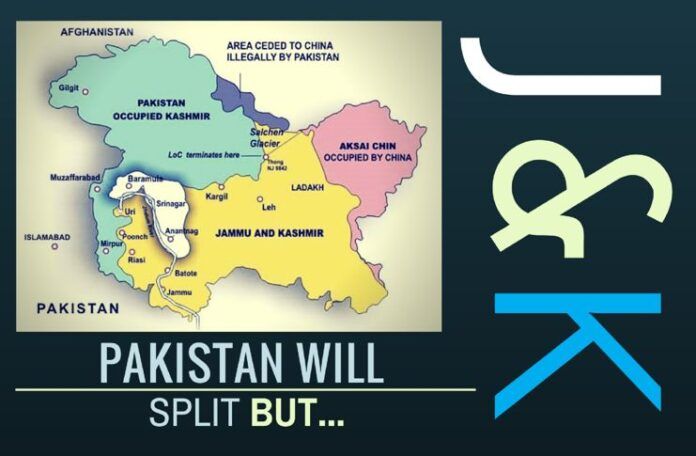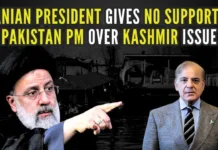
[dropcap color=”#008040″ boxed=”yes” boxed_radius=”8px” class=”” id=””]A[/dropcap]ddressing a “Shahid Diwas’ function in Jammu’s Kathua on December 11, Union home Minister Rajnath Singh made two very significant statements. One was that “India cannot get divided on religion anymore”. The other was that “Pakistan will split on its own, without India meddling in its affairs”.
India knows what communal partition means. It also knows that Jammu, which is known as the City of Temples, is also called the “Capital of Refugees”.
The statements assume greater significance as the Home Minister made them in Jammu itself – winter capital of Jammu & Kashmir State. These came at a time when even the so-called mainstream Kashmiri Sunni leaders such as National Conference President Farooq Abdullah and his son Omar Abdullah have upped the ante against India by swinging solidly behind the Hurriyat Conference, a Pakistan-founded, aided, guided and directed outfit, committed to the Pakistani cause and Jammu & Kashmir’s secession from India.
Home Minister Rajnath Singh’s statement that India could not be divided on the score of religion anymore was an unambiguous response of the Indian State to the Kashmiri jihadis and Farooq Abdullah and ilk. India knows what communal partition means. It also knows that Jammu, which is known as the City of Temples, is also called the “Capital of Refugees”.
There are lakhs of Hindu and Sikh refugees living in different parts of Jammu. They are from Pakistan (all Hindus, mostly Dalits), from PoJK (all Hindus and Sikhs) and from Kashmir Valley itself (all Hindus plus a few hundred Sikhs). While the persecuted minorities quit Pakistan and PoJK in 1947 in the wake of the communal partition of India to escape the wrath of the ardent believers in the concept of 2-nation, Kashmiri Hindus vacated their original habitat – Valley – in January 1990 for the same reasons. So, it was very appropriate on the part of the Home Minister to make it loud and clear that India will not allow another communal partition just for the reason that a particular region houses people professing a particular faith.
[dropcap color=”#008040″ boxed=”yes” boxed_radius=”8px” class=”” id=””]E[/dropcap]qually candid was the Home Minister’s response to Pakistan that it will split into ten parts in case it refused to behave like a responsible State behaves. Pakistan has mobilised all its resources, Army, Rangers and deadly terror outfits to keep the International Border and the Line of Control very hot, as also to destabilise the whole country by seeking to foment anti-India troubles in the Valley and some sensitive parts of Jammu region bordering Pakistan and Pakistan-occupied-Jammu & Kashmir (PoJK). His assertion that Pakistan will split was a warning of sorts and was not based on heresy. He spoke only the truth given the prevailing situation in Pakistan where the Balochs, the Sindhis, the Pathans and the Shiite Muslims are up in arms against the Punjabi Sunnis.
Muslim League leaders are ignorant of Islam, have no ideology, and are only exploiting the name of Islam for the worldly gains of Muslim vested interests
The Home Minister’s assessment about the political future of Pakistan was absolutely correct; and it was not an off-the-cuff remark. What Rajnath Singh said in Jammu was what Jamiat Ulama-i-Hind, the political organ of the Deoband ulama, had predicted immediately after the Muslim League adopted Pakistan resolution on March 23, 1940 on the bank of River Ravi in Lahore under the presidentship of Mohammad Ali Jinnah.
The Jamiat Ulama-i-Hind was bitterly opposed to the Pakistan plan. Its arguments against the Muslim separatism were:
-
“The Pakistan demand has British support and is nothing but an instrument forged by them to further their policy of divide and rule;”
-
“Pakistan will split and, therefore, weaken the Muslims in India;”
-
“Our real enemy is British imperialism and our only duty to defeat it and only a united action can achieve this”;
-
“Muslims left behind India after separation will be at the mercy of the Hindus”;
-
“Partition will hinder the missionary activities of the Ulema”;
-
“Muslim League leaders are ignorant of Islam, have no ideology, and are only exploiting the name of Islam for the worldly gains of Muslim vested interests”; and
-
“Muslim League leaders are incapable of building up an Islamic State and their Pakistan will be no better than the Turkey of Mustafa Kamal”.
[dropcap color=”#008040″ boxed=”yes” boxed_radius=”8px” class=”” id=””]H[/dropcap]owever, to say is not to suggest that the Jamiat Ulama-i-Hind was for non-Islamic India. It was not. It did offer support to the Congress in its “struggle against the British” and neutralise the influence of the Muslim League and the Aligarh School of Thought, but its real objective was to reestablish Muslim rule in India.
Earlier between 1905 and 1915, when the Dar-ul-Uloom was headed by Maulana Mahmud Hasan, called by the Deobandis as “Sheikh-ul-Hind”, the religious seminary had planned an invasion of India.
The Deoband divines, who in 1867 had founded Dar-ul-Uloom (House of Learning) at Deoband in the Saharanpur district of the then United Provinces under the guidance of Maulana Mohammad Qasim Nanawtawi as a counterpoise to Sir Syed Ahmad Khan’s west-oriented Aligarh movement, along with advancing the Hanafi school of theology and impart instructions in Islamic history and other old-fashioned disciplines, set up Jamiat-Ulama-i-Hind in 1919 to play “more important role in the Khilafat movement and enter the political field in their own right”.
The aims and objectives of the Jamiat Ulama-i-Hind were “to defend Islam, Islamic rituals and customs and Islamic nationalism against all odds injurious to them”; “to achieve and protect the general religious and national rights of the Muslims”; “to establish good and friendly relations with the non-Muslims of the country to the extent permitted by the Shariat-i-Islamiya”; and “to fight for the freedom of the country and religion according to the Shari objectives” (Sayyid Muhammad Mian, Jamiat-ul-Ulama Kia Hai, Part I, P.10).
Earlier between 1905 and 1915, when the Dar-ul-Uloom was headed by Maulana Mahmud Hasan, called by the Deobandis as “Sheikh-ul-Hind”, the religious seminary had planned an invasion of India. His “programme consisted of bringing the governments of Afghanistan and Iran together to each other on some workable point of view and seeking the military support of Turkey to attack India through Iran and Afghanistan”.
[dropcap color=”#008040″ boxed=”yes” boxed_radius=”8px” class=”” id=””]I[/dropcap]t needs to be underlined that the Jamiat Ulama-i-Hind supported the Congress as far as the cause of independence of India was concerned. It was its belief that the Muslim minority in India “need have no fear as once the British were gone, the Hindus would come to terms with it”. In 1928, the Jamiat Ulama-i-Hind rejected the Motilal Nehru Committee Report and withdrew from the movement. Its grouses against the Congress and the Nehru Committee Report were two: Inadequate safeguards for the Muslims and the adoption by the Congress of the Dominion status goal, instead of complete independence goal. The Dominion status for India was not consistent with its “commitment to complete independence” (Waheed-us-Zaman, Towards Pakistan, P. 177).
In any case, it must be said that Home Minister Rajnath Singh only indicated what the direction Pakistan is heading towards.
All this should set the record straight and expose the credentials of the Deoband Ulema. And we should also not forget that the followers of Deoband are in strength in Pakistan and they must be treading the path the Deoband Ulema and the Jamiat Ulama-i-Hind charted as early as in 1919.
In any case, it must be said that Home Minister Rajnath Singh only indicated what the direction Pakistan is heading towards. At the same time, we would do well to read the writing on the wall, isolate the enemies within and undertake measures at various levels to comprehensively defeat those whose single-point agenda all along has been to reach Delhi through Kashmir. Prime Minister Narendra Modi has the required mandate behind him and he has also given the nation to understand that he can take bold decisions.
- ‘Kashmir My core constituency’: Revisiting July 12, 2003 to understand politics, Omar Abdullah-style - March 15, 2024
- Total deviation from traditional approach: Seven takeaways from PM Modi’s March 7 Srinagar visit - March 9, 2024
- Status of political parties: Why is further J&K reorganization imperative? - March 1, 2024











Forget akhand bharat. First task is to get to the bharat at 1947. It is hight time we Get our pok back. A war is necessary for it, so be it. China is solidifying in that area day by day.
I disagree with u Mr panigrahi…. U are a general so u have much more knowledge about geopolitics but inclusion of Pakistan means u are including an extreme ideology….. We ourselves in India have been living in denial about this ideology presented by Muslims and had to pay price…. But including Pakistan and making it preindependence bharat geographically would make it worse…. I am not against Muslims…. They are pretty peaceful but I am against the… Mullah ka Islam.. Which is prevalent pretty widely in Pakistan…… The liberal Pakistan is a fallacy….. Rest u can understand better
India’s interest need not be disintegration of Pakistan into unmanageable parts but in formation of a federation of states consisting of all land mass of ‘Akhand Bharat’ or in formation of pre British Akhand Bharat itself .This can usher in strength, stability and sensibility to all components for peaceful coexistence among peoples.